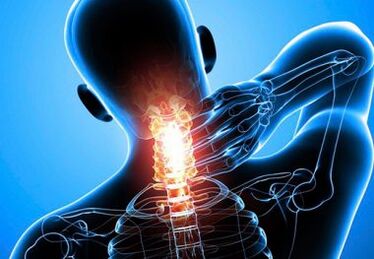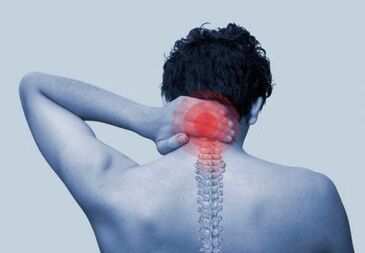Symptoms of cervical osteochondrosis are manifestations of dystrophic changes in cartilage tissue and intervertebral discs. The development of the pathology contributes to the sinking, deformation of the vertebrae. As a result, the patient feels pain, dizziness, nausea.

Osteochondrosis of the cervical spine is accompanied by constant or recurrent cervical pain. This is the most basic symptom of cervical osteochondrosis.
The first symptoms
The cervical spine contains the main blood vessels that feed the brain. Micro-impulses from the main organ and the central nervous system pass through the nerve fibers. The severity of the symptoms depends on the degree of the disease, on the individual characteristics. With cervical osteochondrosis, the discs that perform the amortization function are negatively affected:
- The structure is changing.
- The growths are formed in the form of ridges due to the growth of bone tissue in osteochondrosis. As a result, the blood supply deteriorates and nerve fibers malfunction.
The first symptoms of the disease are not expressed.

With the development of osteochondrosis that appears in the neck, intense pain is observed - the main symptom. During movements, the discomfort intensifies, muscle tension occurs.
Different categories of people are at risk. The process is determined by factors that cause the development of cervical osteochondrosis:
- sedentary lifestyle;
- overweight;
- concomitant pathologies - scoliosis, rheumatism;
- excessive physical activity;
- spinal injury.
The main symptoms in the final stages of development of neck osteochondrosis
Changes in cartilaginous tissue are manifested in the form of signs, the severity of which depends on the severity of dystrophic disorders. The processes can lead to the malfunction of any internal system of the body:
- The compression of nerve endings is characterized by symptoms in the form of osteochondrosis neuralgia. When the spinal cord is pinched, neurological diseases can occur. The bone growths that form in the nerve roots partially or totally immobilize the vertebrae, which leads to their fusion. The disappearance of sensitivity is observed.
- The compression of the main and peripheral blood vessels is the reason for the lack of adequate blood circulation. Oxygen hunger occurs, cardiac function worsens. Symptoms of the cervical type of osteochondrosis: frequent migraines, increased blood pressure, impaired coordination, vascular dystonia, dysfunction of the respiratory system. There may be hearing and vision problems.
External manifestations of cervical osteochondrosis
External symptoms are characterized by a wide range of damage to the body. Patients do not complain of deteriorating general well-being in the first stage pathology. To prevent the onset of the disease, it is recommended to lead an active lifestyle, practice swimming and do gymnastics to improve health.

The sensation in the cervical osteochondrosis of the second phase is characterized by the pain syndrome, which leads to rigidity of movements.
The feeling of discomfort can be located in different areas of the spine. The patient's performance decreases. The compression of the arteries causes general weakness, migraine. Inclinations, head turns increase discomfort in osteochondrosis.
The third stage of the disease is determined by more pronounced symptoms: when palpating the pathological area, there is acute pain, immobility, movements are characterized by crushing, dizziness, nausea. The condition is manifested by loss of consciousness, the patient feels a lump in the throat. The violation of blood circulation leads to spikes in blood pressure and hypertension. Numbness of the upper limbs occurs.
The fourth stage is determined by the deterioration of the condition. With an advanced form of cervical osteochondrosis, the patient's disability may occur. The main symptom is immobilization of the cervical vertebrae. The compression of arteries and nerve fibers reaches maximum levels, which is manifested in the form of tinnitus, visual impairment, hearing. There is a violation of speech - numbness of the tongue, loss of coordination.
The treatment of osteochondrosis located in the neck region is done by a conservative method of drug therapy.
The doctor prescribes physical therapy, gymnastics to improve health. To eliminate the pain syndrome during the exacerbation of the pathology, it is recommended to go through a course of restorative massage.
Internal symptoms and manifestations of osteochondrosis in the cervical spine
Internal symptoms characterize the changes that occur in the structure of the cartilaginous tissue in osteochondrosis:
- Stage I of the manifestation of chondrosis. The physiological structure of the ridge is disrupted. The location of the discs between the vertebrae narrows due to the lack of fluid. Muscle hypertonicity occurs.
- Stage II of osteochondrosis of the neck is determined by the thinning of the intervertebral discs, their height decreases, which increases the load on the musculoskeletal system. The result is pain.
- Stage III. Cartilage deformation occurs, bone tissue proliferation is observed, intervertebral hernias are formed, protrusion occurs. Cases of falling discs have been recorded. The symptoms of the disease are characterized by severity. Arthrosis begins to progress.
- Stage IV. Complete destruction of the discs located between the vertebrae with subsequent replacement of the voids by bone or connective tissue. The process leads to the formation of accumulations.

To prevent the development of the disease, regular exercise at home is recommended, aimed at strengthening the muscle corset with osteochondrosis. To relieve pain, special medications, ointments and injections are prescribed. Folk remedies are used in the form of compresses, bandages.
Are the symptoms different between women and men?
The neck is the most mobile part of the musculoskeletal system, it has 7 vertebrae. The division begins with the pectoral and is attached to the skull. The signs of cervical osteochondrosis in women do not differ from pathological manifestations in men. According to statistics, women are more prone to the onset of the disease, which is due to the anatomical structure, possible pregnancy.
The course of the disease depends on concomitant conditions, hormone levels, symptoms and other factors.
| Differences | Men | Women |
| Column cross section | Bigger size. | Smaller. |
| System functions | The body is subject to constant stress. Fractures are less common due to more developed muscles. | It adapts better to loads. Osteochondrosis, scoliosis-shaped curvature, osteoporosis are often diagnosed. |
| Clinical condition | The condition is characterized by stability. Lower pain threshold. Patients are unable to clearly describe all signs. | The symptoms are pronounced. Patients articulate complaints clearly. |
| Age changes | The body is not subject to restructuring of internal systems until 45-50 years. | Changes are seen as a result of pregnancy, hormonal changes after the age of 45. Pain, numbness of the hands may occur. |
Carrying a fetus may be accompanied by the appearance of symptoms:
- progression of cervical and lumbar osteochondrosis;
- clamping of nerve endings;
- the occurrence of problems in the cardiovascular system;
- rigidity of movement.
Be sure to watch an excerpt from the popular health program. This edition lists in detail all the main symptoms of cervical osteochondrosis:
Diagnosis of osteochondrosis of the cervical spine
The comprehensive diagnosis of osteochondrosis that arises in the neck region, taking into account the degree of the disease, the symptoms, is the key to a favorable course of the disease. To establish an accurate diagnosis, several methods are used:
- Inspection. After consulting a doctor, a visual assessment is performed using the parameter - gait, posture. A complete history of the patient's symptoms is obtained.
- Radiography is considered an accessible examination method. It is characterized by the possible occurrence of consequences that affect the general well-being of the patient. A photo of the cervical spine is taken from the base of the skull to the top of the chest. The study shows the condition of the intervertebral discs.
- Tomography. There are two types: computerized image and magnetic resonance imaging (MRI). In the first case, with the help of a special device, a specialist makes cuts under the influence of X-rays. The resulting image is displayed on the computer screen, a 3D model is executed. The second type of examination is based on the work of electromagnetic waves. Layer-by-layer images of a specific part of the body are obtained.

If symptoms of osteochondrosis in the neck are characterized by intensive development, you should see a doctor.
Prevention of osteochondrosis of the neck
For the prevention of the disease, it is recommended to have an active lifestyle, exercise constantly and practice swimming. With an advanced form of pathology, a course of treatment is prescribed, including taking pain-relieving drugs, normalizing the functioning of the body's internal systems.






















